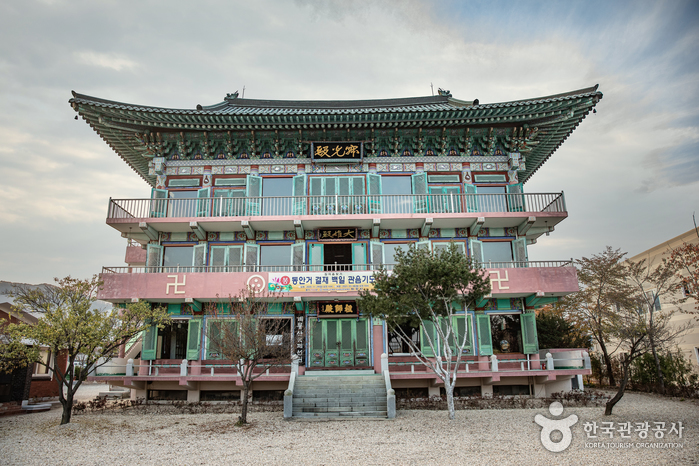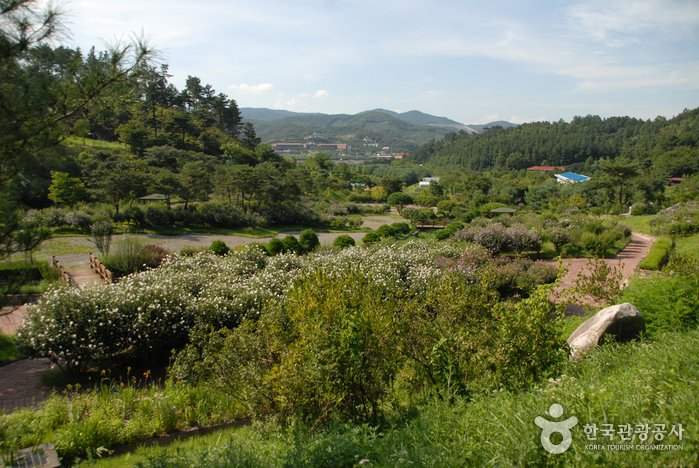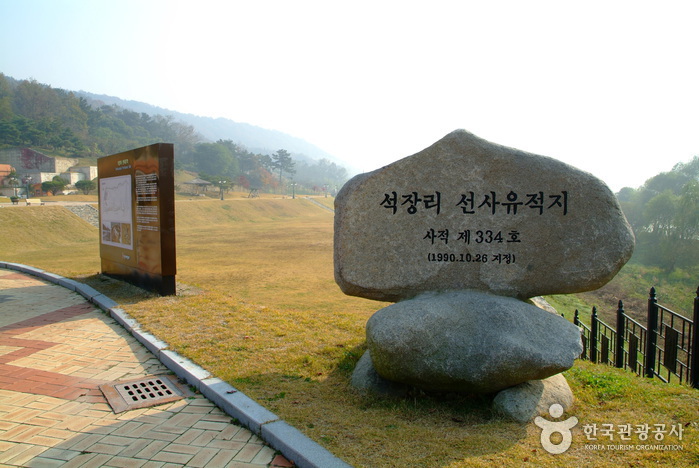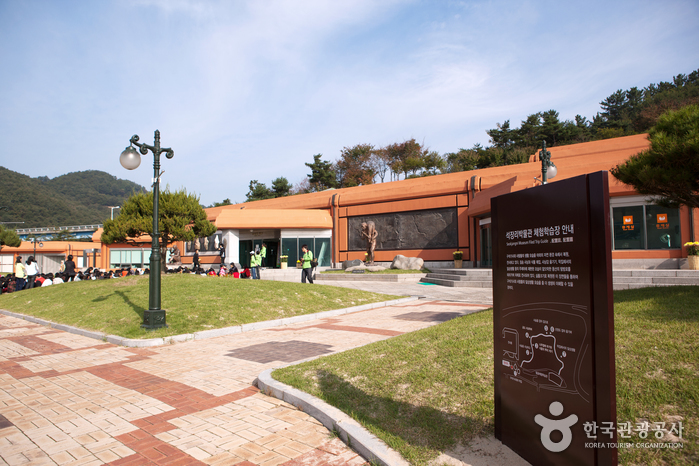Daejeon National Cemetery Patrotic Footpath (국립대전현충원 보훈둘레길)
11.2 Km 27063 2021-08-18
251, Hyeonchungwon-ro, Yuseong-gu, Daejeon
+82-42-718-7114
Daejeon National Cemetery covers a vast area of land spanning 330,000 ㎡. The cemetery is comprised of graves for the deceased patriots, men of national merit, generals, officers, soldiers, and more. Major facilities include the Memorial Tower and Memorial Gate for paying reverence to the deceased patriots, Patriotic Spirit Exhibition Center displaying photos and articles left by the deceased, and an outdoor exhibition space, where military battle equipment is on display. Other facilities within the cemetery grounds include fountains, statues, sculptures, pavilions, and Hyeonchungji Pond, a man-made pond in the shape of the Korean peninsula. In particular, the memorial site's Patriotic Footpath serves as a great walking path for those who seek to tour the nearby areas on foot. There are a total of seven walking trails that pass by beautiful and meaningful attractions.
Daejeon Jagwangsa Temple (자광사(대전))
12.0 Km 8001 2021-09-07
50-8, Hakhadong-ro 63beon-gil, Yuseong-gu, Daejeon
+82-42-822-9220
Legend has it that the region of Hakha-dong was where the gods lived when they periodically came down from the heavens. When Jagwangsa Temple was built in the district, Song Siyeol saw it as a sign and created a village school near the temple to train his pupils. It was his hope that the sacred land would aide in the raising of gifted students who would grow to serve their community and country. When building the school, Song Siyeol also planted a juniper tree that, 300 years later, still proudly stands by Jagwangsa Temple.
Upon entering the temple area, visitors will find to their left the Seongjeonnyeongdangji Memorial Stone, which serves to commemorate Song Siyeol and his school. Next to the memorial stone is a pond in which carp swim lazily around lotus flowers. From the white wooden chair in front of the pond, there is a large bell to the left and main Dharma Hall to the right.
Dasom Chaban (다솜차반)
12.1 Km 2 2024-02-13
29 Gyebaek-ro 421beon-gil, Yuseong-gu, Daejeon
Dasom Chaban is a Korean table d'hote restaurant celebrated for its picturesque garden setting. The restaurant presents a range of meticulously crafted full-course meals, distinguished by their tidy presentation and ample portions. The standout dish is the geongang borigulbi jeongsik (barley-aged dried yellow croaker set menu), featuring an appetizer, assorted side dishes, and over ten different delicacies, with bori gulbi as the main course. Nestled on the outskirts of Daejeon, it offers an ideal retreat for a leisurely drive and a delightful dining experience.
Geumgang Recreational Forest (Arboretum, Forest Museum) (금강자연휴양림(금강수목원,산림박물관))
12.3 Km 76633 2021-04-29
110, Sallimbangmulgwan-gil, Sejong-si
+82-41-635-7400
Along the river from Gongju toward Daejeon there is Geumgang River to the right. Following this river, there is a red arch-shaped bridge on the right called Bultigyo Bridge. Geumgang Recreational Forest, a large and well-organized forest, is located on the other side of this bridge. In the past, this remote village can only be reached by boat. In 1994, the Chungnam Forest Environment Research Institute moved to this area and designated the well-preserved dense forest as Geumgang Recreational Forest, and the Forest Museum opened in October 1997. Geumgang Recreational Forest is different from other recreational forests. Rather than a dense forest with a trail, this forest has a variety of attractions such as the Forest Museum, an arboretum, greenhouse, pond, and wildlife park scattered on well-maintained roads, giving the impression of a city park.
Archaeological Site in Seokjang-ri, Gongju (공주 석장리 유적)
12.7 Km 33129 2021-07-17
990, Geumbyeok-ro, Gongju-si, Chungcheongnam-do
+82-41-840-8924
The Archaeological Site in Seokjang-ri, Gongju is located approximately 6 kilometers out of the city of Gongju, on the northern banks of the Geumgang River. The site is one of Korea's representative relic sites of the Old Stone Age, and is designated Historic Site No. 334. The site was excavated 10 times between 1964 and 1974 by teams from Yonsei University Museum. The excavation of 27 layers of stratum produced relics proving people lived in the area through 11 cultural eras. The area was excavated again in 1990 and 1993, producing even more cultural artifacts and helping to create a clearer image of the people living in that time.
Jinjamhyanggyo Confucian School (진잠향교)
12.7 Km 5244 2022-12-26
67, Gyochon-ro, Yuseong-gu, Daejeon
+82-42-543-1811
Jinjamhyanggyo Confucian School was established to enshrine and orient the ancestral tablet of excellent classical scholars in 1405 (the 5th year of King Taejong's reign) and to educate people. More detailed information is not available in the record. The remaining building is called Daeseongjeon, and the ancestral tablets are 5 Seong, Songju 6 hyeon, and Korean 18 hyeon. One instructor, who received a plot of land and slaves from the nation, taught 30 students during the Joseon period, but after the Gapo Reform, the educational function disappeared and Seokjeon, a religious ceremony, was served in summer and fall with offerings of incense on the first day of each month and at the half-moon instead. Daeseongjeon (Cheongju Daeseong High School (Former Main Building of Cheongju Commercial High School) is designated as a Registered Cultural Heritage.
Seokjangni Museum (석장리박물관)
12.7 Km 37251 2021-12-24
990, Geumbyeok-ro, Gongju-si, Chungcheongnam-do
+82-41-840-8924
Located in Gongju, Chungcheongnam-do, Seokjangni Museum was established in September 2006 to preserve and introduce the culture of the Old Stone Age. There are a variety of exhibitions of relics excavated from the Seokjeong-ri area as well as educational programs available for visitors to learn more about the Paleolithic Period. The museum is divided into permanent exhibitions, planned exhibitions and outdoor exhibitions. Overall, visitors can understand the history better through the exhibition halls, prehistoric park, and the Archaeological Site in Seokjang-ri, Gongju.
Homeplus - Seodaejeon Branch [Tax Refund Shop] (홈플러스 서대전)
12.8 Km 0 2024-04-18
23, Daejeong-ro, Yuseong-gu, Daejeon
-
Moda Outlet - Daejeon Branch [Tax Refund Shop] (모다아울렛 대전점)
12.9 Km 0 2024-04-18
5, Daejeong-ro, Yuseong-gu, Daejeon
-
Gyeryong Samgyetang (계룡삼계탕)
13.0 Km 3271 2024-02-13
33 Jinjam-ro 92beon-gil, Yuseong-gu, Daejeon
Gyeryong Samgyetang is a Korean restaurant specializing in samgyetang (ginseng chicken soup), a traditional nutritious food. The signature menu is the yak nokdu samgyetang (mung beans and ginseng chicken soup), prepared with over 10 medicinal herbs to replenish the body's energy. The samgyetang is served in a hot pot, providing a warm and satisfying meal. The meat is very tender, and the broth has a rich flavor.





![Homeplus - Seodaejeon Branch [Tax Refund Shop] (홈플러스 서대전)](http://tong.visitkorea.or.kr/cms/resource/52/2883552_image2_1.jpg)
![Moda Outlet - Daejeon Branch [Tax Refund Shop] (모다아울렛 대전점)](http://tong.visitkorea.or.kr/cms/resource/56/2883556_image2_1.jpg)
 English
English
 한국어
한국어 日本語
日本語 中文(简体)
中文(简体) Deutsch
Deutsch Français
Français Español
Español Русский
Русский